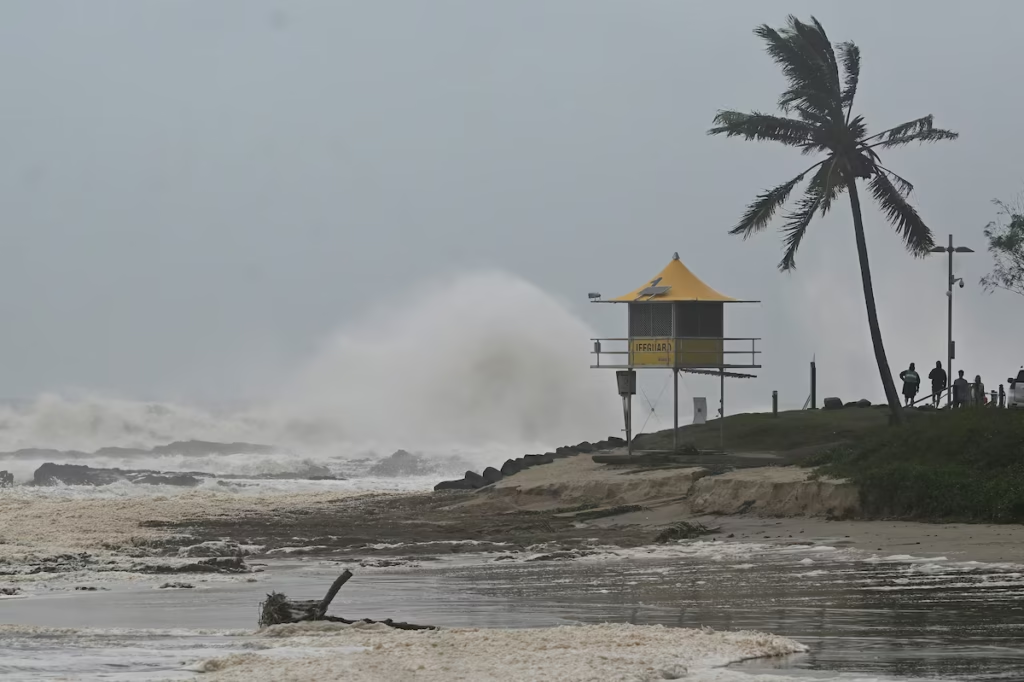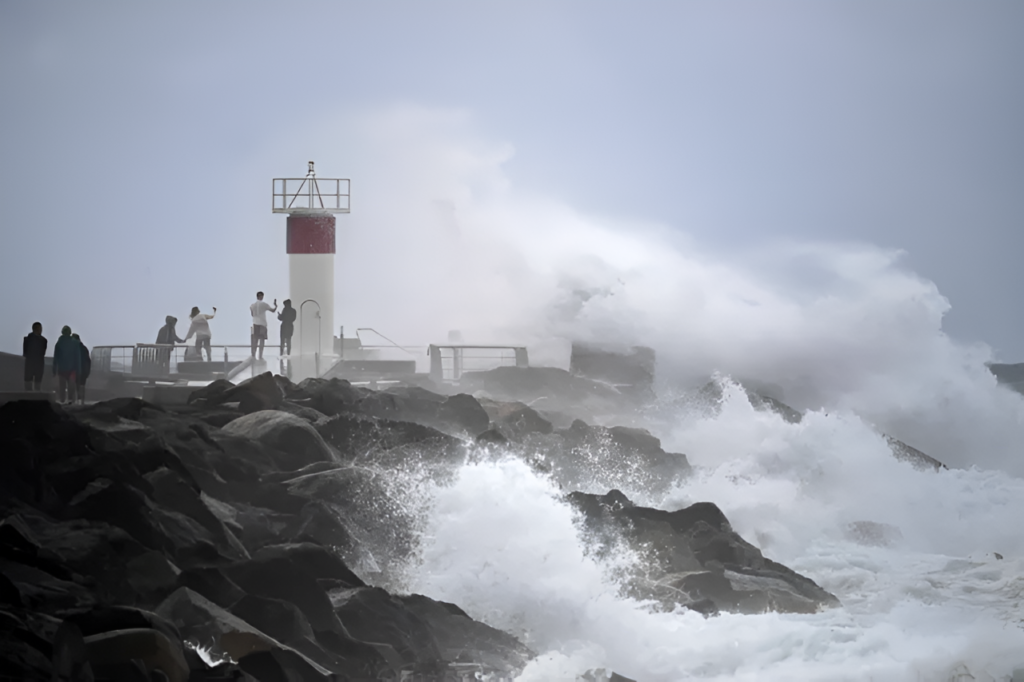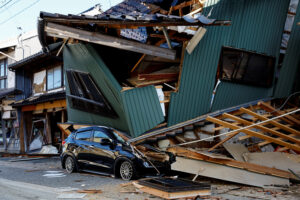Australians Face Power Outages and Flood Warnings as Tropical Cyclone Alfred Wreaks Havoc Across Queensland
Hundreds of thousands of Australians in Queensland were left grappling with widespread power outages, school closures, and rising flood risks on Sunday, as the remnants of Tropical Cyclone Alfred unleashed destructive winds and relentless rainfall across the state’s southeast. Although the storm had weakened to a tropical low, it continued to cause chaos, with authorities warning that the danger was far from over.
Despite losing its cyclone status, Alfred’s lingering effects have been catastrophic, with 316,540 people without power, major infrastructure damage, and communities bracing for prolonged impacts as floodwaters rise. The storm hit the coast after maintaining cyclone status for an astonishing 16 days, before slowly making its way inland and dumping torrential rain across key population centers.
The state’s Bureau of Meteorology (BOM) has warned that the severe weather could intensify, threatening Brisbane, Ipswich, Sunshine Coast, and Gympie with heavy rainfall capable of triggering flash floods. Meanwhile, damaging winds with gusts up to 90 km/h (60 mph) remain a possibility, raising concerns of further damage to power lines and homes.
Evolving situation, the emergency response, and what lies ahead for impacted Australians.
The Storm’s Path: From Cyclone to Coastal Catastrophe
Tropical Cyclone Alfred formed over the Coral Sea, gaining strength and swirling over open waters for more than two weeks before moving toward the Queensland coast. By the time it made landfall on Saturday, it had weakened to a tropical low, but the system’s sheer size and slow movement ensured that heavy rainfall and damaging winds persisted.
According to Dean Narramore, a meteorologist with the Bureau of Meteorology, the storm had lost its intensity but remained a threat due to the sheer volume of rain it carried.
“It is now just a weak low as it continues moving further inland through southeast Queensland, bringing lots of rain,” Narramore explained.
The storm’s trajectory meant prolonged rainfall for already saturated catchments, with major rivers swelling and threatening to overflow into nearby communities.

Power Outages and Infrastructure Devastation
The storm’s arrival led to catastrophic power outages across Queensland, with Energex reporting that 316,540 people were without electricity at the peak of the storm. The Gold Coast was the hardest-hit area, with over 112,000 residents plunged into darkness.
Fierce winds and falling trees brought down power lines and damaged substations, while debris-strewn roads made it difficult for repair crews to reach the worst-affected areas. Even as restoration efforts began, continued rain and the risk of flash floods complicated recovery operations.
Premier David Crisafulli acknowledged the scale of the damage in his public remarks, noting that Australians on the Gold Coast were facing significant disruption.
“Where it’s safe to do so, schools will reopen with the exception of the Gold Coast, where there remains some significant damage — power loss and issues with transport,” Crisafulli said in televised comments from Brisbane.
The government has promised that repair efforts will continue around the clock, but for many Australians, the reality is that full power restoration could take days or even weeks in the most severely affected areas.
School Closures and Transport Chaos
The storm’s impact was so severe that authorities preemptively closed around 1,000 state schools on Friday, prioritizing student safety as conditions worsened. As of Sunday, the decision on whether schools would reopen on Monday remained uncertain, with officials carefully assessing damage and accessibility.
While schools in Brisbane and other areas may reopen, the Gold Coast — where damage was most severe — could see prolonged closures due to ongoing power outages and transport disruptions. Public transport services were also severely impacted, with flooded roads and debris making some routes impassable.
Even Brisbane Airport, a critical transport hub, was forced to shut down temporarily but managed to reopen by Sunday. However, in a social media post on X (formerly Twitter), airport officials warned passengers that weather-related disruptions could still affect flights.
“Ongoing weather may affect the schedule,” the post read, urging travelers to check with their airlines for the latest updates.
For thousands of Australians, the combination of closed schools, transport issues, and power outages has made daily life incredibly challenging, with many turning to community support networks to navigate the crisis.
Government and Emergency Response Efforts
In response to the unfolding disaster, government officials and emergency services have ramped up their efforts to protect communities and begin recovery operations. Prime Minister Anthony Albanese spoke about the severity of the situation, emphasizing the federal government’s commitment to supporting impacted regions.
“The situation in Queensland and northern New South Wales remains very serious due to flash flooding and heavy winds,” Albanese said in a televised statement from Canberra.
“Heavy rainfall, damaging wind gusts, and coastal surf impacts are expected to continue over coming days.”
Emergency services have been stretched to their limits, with the State Emergency Service (SES) fielding thousands of distress calls. Volunteers have rescued stranded residents, sandbagged homes, and delivered essential supplies to those cut off by floodwaters.
Helicopters have conducted aerial reconnaissance, identifying the hardest-hit areas and coordinating ground response efforts. Meanwhile, community centers have transformed into temporary shelters, providing refuge for displaced families.

The Human Toll and Community Resilience
While the storm’s physical damage is vast, the emotional toll on affected Australians is equally significant. Families have lost homes, businesses are facing crippling disruptions, and entire communities are grappling with the uncertainty of what comes next.
Despite the adversity, stories of resilience and community spirit are shining through. Neighbors are helping each other clear debris, local businesses are offering free meals and supplies to those in need, and volunteers are working tirelessly to support recovery efforts.
One Ipswich resident, Jackie Evans, shared her experience of weathering the storm:
“The wind was so strong, I thought our windows were going to shatter. We lost power early on, and the kids were terrified. But the next morning, the whole street was out, helping each other. That’s the Aussie spirit.”
What Lies Ahead for Australians
The Bureau of Meteorology has warned that while the immediate threat of Tropical Cyclone Alfred may be receding, the risk of flooding remains high. Rivers and dams are nearing capacity, and any additional rainfall could trigger dangerous flash floods.
Authorities have urged residents to remain alert, avoid unnecessary travel, and stay updated on weather alerts. The Queensland and federal governments are coordinating long-term recovery efforts, including financial assistance packages and infrastructure repair plans.
For many Australians, the coming weeks will be a test of endurance, patience, and community solidarity. But if history is any guide, the people of Queensland will face this challenge head-on — rebuilding, supporting one another, and emerging even stronger.
Australians Rise Above the Storm
While Tropical Cyclone Alfred may have battered Queensland, it failed to break the spirit of its people. From emergency responders risking their lives to protect others, to neighbors rallying together to clean up and rebuild, this disaster has once again showcased the resilience and determination that define Australians.
As the floodwaters recede and power is gradually restored, communities will begin the long process of healing. And though the scars left by Alfred will linger, the strength, compassion, and unwavering resolve of Australians will shine even brighter.
Would you like me to refine this further or add any more elements? Let me know — I’m here to help! 🌟










